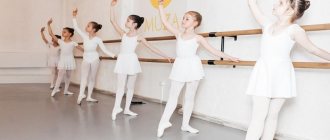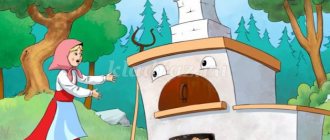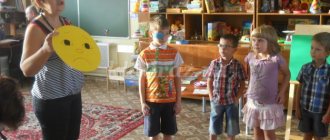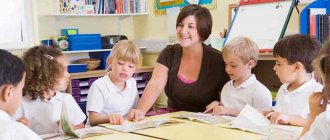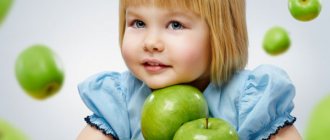Physical development of children through dancing
Children who regularly attend classes at a dance school enjoy good health. Properly selected physical activity and activity in the classroom contribute to:
- Strengthening all muscle groups;
- Formation of correct posture;
- Development of endurance;
- Improving the functioning of the heart and lungs, strengthening blood vessels;
- Development of coordination of movements, “muscle memory”;
- Development of flexibility and plasticity;
- Development of dexterity and speed of reaction.
Correct execution of dance movements requires school and considerable physical effort, but, unlike sports, dance lessons are practically harmless and have no contraindications.
Intellectual development of children
It may seem that active activities have little effect on children's intellectual development. But this is absolutely not true! Memorizing movements and their combinations perfectly trains the memory of preschoolers, and the need to constantly monitor the music, teacher and friends in the lesson perfectly develops attention. Lessons at the dance school develop spatial thinking, the baby quickly learns to perceive the concepts of “top”, “bottom”, “right”, “left”, “side”, “in the middle”, “above”, “under”, “in front”, “ for" and so on. To transform into the image necessary for the dance, the child actively uses his imagination. In general, intelligence is the ability to adapt to new conditions and learn quickly. During classes, children not only perform prepared dances, but also often improvise. By getting to know himself and the capabilities of his body, the baby creates a fundamental basis for new discoveries.
Summer is the time to experiment
Any event will become brighter, more exciting and more varied if the guys prepare a beautiful summer dance, with original costumes and stage design. After all, summer is a time of experimentation, and dance art is the best platform for the creative process. As a rule, summer dances are prepared in advance and the following is thought out:
- direction;
- style;
- movements;
- number of participants;
- musical accompaniment.
But there are exceptions, when dances at a summer camp are performed in improvisation mode, it can be an interesting competition or a disco show. This is quite an interesting and fun activity, as it does not require additional preparation, and children can move to the music in a way that is interesting and comfortable for them and there is absolutely no need to adapt to each other and dance in unison.
An important place is occupied by the mood of the dancers during the performance, namely, kind smiles on their faces and eyes shining with happiness. This will give you the opportunity to charge the auditorium with rhythm and positivity. In the process of performing a children's summer dance , it reveals to the audience all the beauties of this season of the year:
- bright sun;
- wonderful mood;
- fun swimming;
- walks in the forest;
- funny Games;
- camping;
- a lot of joy and laughter.
So, summer dance for children is a whole story about what summer is and how fun it can be spent with friends, family, counselors and campmates. And what a great opportunity to give people happiness and give them the opportunity to smile at life and the surrounding summer sun.
Artistic and aesthetic development in dance school
Dancing instills in preschoolers a love of art, a sense of beauty, and also opens up for them a new way of perceiving the world - through music and movement. A variety of forms of conveying feelings is formed in the dance school through immersion in various images. With the help of plastic arts and artistic movement, children learn to express their creative ideas, moods, and thoughts. Babies also develop an ear for music and a sense of rhythm. Dance lessons undoubtedly contribute to the artistic and aesthetic development of preschool children.
The unity of movements and music is a special way of perceiving the world, which opens up to the child during dance classes and remains with him for life.
Children's dance school
Dance directions
Modern choreography
Rhythm, plasticity, stretching - all this is combined in modern children's choreography. This is one of the most popular trends in modern dance schools for children.
Modern
This trend appeared in the USA at the beginning of the last century and is quickly gaining popularity in children's dance schools. Through modern training, young dancers learn not only to control their body, to move from a state of complete relaxation to a state of tone and rhythm, but also gain spiritual harmony and clarity of thought.
Hip-hop
One of the most popular “street” styles, which combines elements from breakdancing, locking and other freestyle styles. The main features of hip-hop in children's dance schools are clear movements and a fair amount of improvisation.
Jazz funk
This style was formed in the 20s of the last century at the intersection of hip-hop, pop art, and jazz styles. In choreography schools in Moscow and other cities, this direction is less developed than others, but the abrupt, sharp movements combined with the smoothness and plasticity characteristic of this dance find their fans.
Jazz Modern
Modern expression, jazz rhythm, and classical choreography techniques are woven together into a unique jazz-modern dance direction. This direction is dynamic and emotional. The main elements of the dance are jumps, rotations, rhythmic and smooth movements of the body. It is especially useful to send an active child to modern jazz dancing. This is a good way to release energy.
House
House is often confused with hip-hop, but this dance in choreography schools for children has its own differences. It is more flexible and helps develop the child’s flexibility, sense of balance and ability to control his body.
R'N'B
This is one of the most fashionable trends in dance schools for children. Clear, fashionable, stylish R'n'B appeals to children of all ages. The dance has a lot of springy movements, turns, and slides, which develop a sense of rhythm and flexibility in children. In addition, this is one of the types of choreography for children and adults, which is often used in music videos and stage productions by stars.
Street jazz
This style came to dance schools for children from street festivals. This is a free dance that not only combines elements from different directions, but also includes a lot of improvisation. The arms, body and legs are equally involved, which makes street jazz an excellent workout and contributes to the physical development of the child.
Features and benefits of classes
For children, dancing at school will become a serious hobby and favorite pastime thanks to the teaching methodology, which has the following advantages:
- Children are taught by experienced teachers.
- Children are offered an individual education program.
- Developing in children the ability to perform on stage and win the sympathy of the audience.
- Lessons for young children take the form of games.
- Children are given exercises to develop a sense of rhythm, hearing and physical fitness.
As a result of attending classes, the child will learn to better control his body, strengthen his muscle corset, master the skill of improvisation, become stronger and more resilient, and develop determination and perseverance.
To instill a love of dance in children from an early age, sign up for a trial lesson on our website!
Development of personal qualities
Listening to music makes a great contribution to the development of a child’s personality, including his emotional sphere, because it contains many experiences, emotions, feelings, and events. Thanks to dancing, children recognize themselves and become well oriented in their inner world. In addition, children develop such qualities as:
- Artistry;
- Creativity;
- Public speaking skills;
- Activity;
- Self confidence;
- Self-control;
- Discipline;
- Determination;
- Persistence.
We can say that this is a whole school of life.
Development of communication skills
Dance lessons help children improve their communication skills. Kids usually make new acquaintances without difficulty, because the atmosphere that prevails at the dance school is conducive to close emotional communication. Even shy and unsociable children are liberated and quickly join the team. Basically, dancing is teamwork, so preschoolers develop a sense of trust in others, and also develop skills of interaction with other people, the ability to find a common language with peers in the class. In choreography lessons, children are taught to express their emotions through facial expressions and gestures, and this greatly helps them better understand how other people feel.
At what age can you start taking dance lessons?
Every parent wants their baby to actively and fully develop, so almost from the very birth of the baby they think about which club to send their child to, which will best prepare them for school. Most sections recruit children over 4 years old. But dancing is exactly the kind of activity that is suitable for children from 2-3 years old. This is due to the level of physical development of children of this age and their needs. At 2 years old, children usually love everything that has to do with movement. They can run, jump, and overcome obstacles almost without stopping. As the vestibular apparatus develops, the ability to maintain balance develops. By the age of 3, movements become more precise and coordinated, and reaction speed increases. From 4-5 years old, preschoolers have access to complex motor skills that require good physical fitness, dexterity, flexibility and speed of reaction. Of course, preschool children, in most cases, cannot master complex choreography and achieve high results. But dancing classes under the guidance of a professional and attentive teacher will allow the child to express himself and fully satisfy his need to be in motion, as well as prepare the basis for future victories. To accurately determine whether your baby is ready for dance classes, you can ask yourself the following questions:
- How does your child prefer to spend his free time? Does he like active or quiet games?
- How does the baby tolerate physical activity?
- Will he be able to listen to the school teacher and fulfill his requirements?
- And most importantly: does the child like to dance? To find out, you can simply watch the baby or invite him to dance with you.
Children aged 2-4 years, along with older preschoolers, can safely be sent to dance lessons, since active physical development occurs at this stage, but the individual characteristics of the child must always be taken into account.
Children's dancing in kindergarten
Most adults believe that dancing is a waste of time. Especially if their child will dance in kindergarten and not study additional mathematics. Are they right? The answer is clear - no.
Dancing is a most interesting and enjoyable activity. Through children's dances in kindergarten, a huge number of tasks related to the development of fine and gross motor skills, ear for music, flexibility and smoothness of movements, skills to work in pairs, in a team, discipline, creativity, intelligence and memory are solved. And most importantly, dancing gives the child the opportunity to have a good time.
Children's dancing in kindergarten puts the right stress on the heart, perfectly trains all muscle groups, joints, vestibular apparatus, and forms correct posture.
But it is worth remembering that it is recommended to start dancing from the age of three. We must understand that in preschool age the foundations of personal, mental and physical development begin to form and be laid. In this type of activity, children memorize dance compositions, learn to interact with each other, improvise and navigate correctly in space.
The teacher, conducting dances in kindergarten, introduces children to the cultural heritage of his country through folk dances. In addition, children love to perform rhythmic movements to modern music, one of the genres is hip-hop. And it doesn’t matter whether the child moves correctly or not, the most important thing is to express yourself through performing movements to the music.
The teacher, when organizing classes, should not keep the child within certain limits; he is obliged to give only a positive assessment of his actions.
At 4–5 years old, children learn simple movements and simple dance compositions. At 6–7 years old, they master more complex movements using props. Children demonstrate their talents at holidays and entertainment events. Parents are amazed by the performances of little dancers. Showing your skills and talent in front of a large audience allows you to get rid of stiffness and feelings of fear, which will undoubtedly come in handy in the future.
Elements of choreography are used in theatrical productions for a more open and vivid development of the plot.
Psychologists have long proven the fact that children who engage in this type of activity are ahead of their peers in development, are successful in their studies, and better develop mathematical and logical concepts, speech, and the ability to quickly navigate in space.
Children's dance helps develop such personality qualities as: hard work, determination, organization. Children who are withdrawn become sociable and relaxed. This type of activity can even help solve some psychological problems, which is why very often mentally retarded children are enrolled in special dance clubs.
As you can see, children's dances in kindergarten bring great benefits for the harmonious and comprehensive development of the child and help him easily make the transition from the position of a preschooler to the position of a schoolchild, successfully mastering educational activities.
In addition, dancing gives the child the opportunity to look positively at the problems occurring in our troubled world.
conclusions
When parents are faced with a choice of which section or club to send their child to, many choose a dance school. And this is exactly what children of early and preschool age need. Dance classes make a great contribution to the physical, intellectual, personal, social and aesthetic development of the child. Children involved in dancing develop self-control skills, the ability to work in a team and collaborate with peers, and listen to the teacher. When going to school, the child will be psychologically prepared for new conditions.
Description of dances for older preschoolers
Dance "Bi-bi-ka"
Children (8 people) stand near the central wall.
Steering wheels in hands.
Loss –
The first four leave, then the second four leave a little further.
1st verse:
— 8 “springs” right – left; - fours change places;
— 8 “springs” right – left; - fours change places;
They show the “horn” with their hand and say: “We’re going, we’re going”!
Chorus:
The first four go to the right, the second four go to the left, meet in the center of the hall, drive through the center and stop.
They show the “horn” with their hand and say: “We’re going, we’re going”!
2nd verse:
- the 1st, 3rd, 5th, 7th child go around the 2nd, 4th, 6th, 8th child;
— tilts – 1st, 3rd, 5th, 7th child to the right, 2nd, 4th, 6th, 8th – to the left;
- stand straight;
— tilts – 1st, 3rd, 5th, 7th child to the left, 2nd, 4th, 6th, 8th – to the right;
- stand straight;
Repeat 2 times.
- the 2nd, 4th, 6th, 8th child go around the 1st, 3rd, 5th, 7th child;
— tilts – 1st, 3rd, 5th, 7th child to the right, 2nd, 4th, 6th, 8th – to the left;
- stand straight;
— tilts – 1st, 3rd, 5th, 7th child to the left, 2nd, 4th, 6th, 8th – to the right;
- stand straight;
Repeat 2 times.
Chorus:
They disperse in different directions with side steps -
- 1st, 3rd, 5th, 7th child to the left, 2nd, 4th, 6th, 8th - to the right;
- circle to the right;
- circle to the left.
Loss:
— ride in a large circle and line up against the central wall.
Chorus:
— the 1st, 3rd, 5th, 7th child goes forward;
- everyone does the “spring” 4 times;
— the 2nd, 4th, 6th, 8th child goes forward
- everyone does the “spring” 4 times;
Repeat 2 times.
At the end they show the “beep” with their hand and say: “We’re going, we’re going, beep!”
Dance for girls at the graduation party “And I’m a modern girl.”
Girls stand in a circle, arms down, large plumes in their hands
Loss: -
The girls wave their arms forward and backward with a spring;
- Hands to shoulders. The toe of the right foot hits near the left foot and vice versa. — Stand in a column in the middle of the hall. 1st verse:
- numbers 1, 3, 5, 7 lunge to the right, the right hand waves to the right; - numbers 2, 4, 6, 8 lunge to the left, the left hand waves to the left;
Then in the other direction. 3 lunges in each direction, and the girls scatter in a cone - the first girls are in the corners, the second are closer to each other, the third are even closer to each other and the fourth are standing in pairs side by side.
Chorus:
— The toe of the right foot hits near the left foot and vice versa (4 times);
- Spin around once, legs overlapping, hands near shoulders. Repeat 2 times. For a small loss, girls make 2 circles. 2nd verse:
- 4 additional steps with a spring in a circle to the right;
— 4 additional steps with a spring in a circle to the left; Chorus:
repeat standing in a circle, but the second time do not spin, but stand in two lines, placing your hands on each other’s shoulders.
Loss:
- Half turn to the left and bend the right leg at the knee twice; - Half turn to the right and bend the left leg at the knee twice; Repeat 3 times in each direction.
Stand in 2 columns:
- 1, 3 numbers in the first column lunge to the right, the right hand waves to the right; - 2, 4 numbers in the first column lunge to the left, the left hand waves to the left; - 1, 3 numbers in the second column lunge to the left, the left hand waves to the left; - 2, 4 numbers in the first column lunge to the right, the right hand waves to the right. Repeat 3 times in each direction.
The girls stand in pairs. - Turn to each other with a spring, hands meet with a boat; — They turn away from each other with a spring, their hands cupped behind their backs. Repeat 4 times in each direction.
Repeat the chorus in pairs.
- At 3 steps they spin to the right and wave their plumes above their heads; - At 3 steps they spin to the right and wave their plumes above their heads; Repeat 2 times in each direction.
